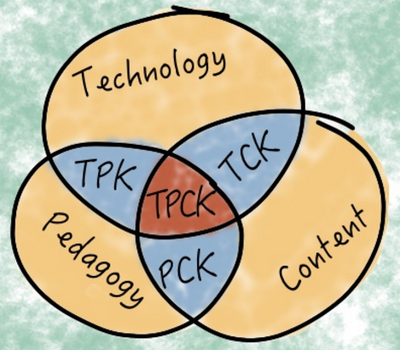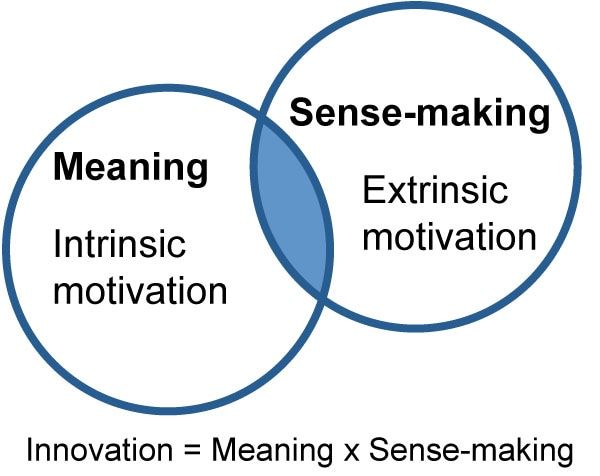|
I feel like I am at a pivotal point with my Capstone and this Masters program. I have learned so much, and am continuing to bring things together. I feel like I am in a reflective stage, trying to determine how to connect the dots and how to think through the best way to design my Capstone so that it provides information, and is easy to use for teachers.
Evolving as an Innovative Thinker This course has made me think very differently about how to present, teach and share information. When I have mentioned that my masters is in Innovative Learning, I get a lot of different questions. "What is that? What is it like?" Having just spent some time with Visible Learning for Literacy the past month with Becky, I'd like to couch my learning from this program in Surface, Deep, and Transfer Learning. Surface Learn about the technology tools that are out there, many of them, play with them, vet them and determine which are the best tool for the right time with students and teachers. Learn about how to become a researcher, and all the nuances that go with compiling and finalizing a research paper. Learn about Instructional Design; many types, variations, and iterations. Learn about current research Deep Taking my surface knowledge and thinking about how to acquire it at a deeper level (understand it), and consolidate it. Now what do I do with this, where can I use this information and how can I connect these different learning TOGETHER. Transfer This is where the fun part comes in, hence my reference to the Calm before the Storm! Applying my different forms of research, knowledge on Instructional Design, and understanding of technology tools to my Capstone. The culmination. Can I take all of this together and make it clear, concise, and meaningful . I spent a good chunk of time this week working through the designing prototype document and revising my prototype to think about how to make it the best it can be. There are so many swirling resources I feel like I am muddying the waters. One of the areas where teachers get stuck is when to move out of the surface and into the deep, every student is different and ready at different times. One of the questioning strategies is called Funneling and Focusing, funneling questions have their place usually in Surface, but Focusing questions allow for deeper learning (ex: what was the setting of the story (funneling) vs. how did the setting influence the story (focusing). It is being able to not just understand the setting, but be able to know how it influenced the story. THIS is what I want to achieve with my capstone website, at least get teachers beyond the surface. I realize Transfer has to happen when they can apply it to another subject area, etc...SO, the goal is for my capstone to at least take teachers through the Surface, and Deep levels of learning, and then thinking of continuous, ongoing learning, with reflection, that would then take them to the Transfer level. Like I said, calm-ish before the storm!
2 Comments
It was nice to revisit TPACK as I think about my Capstone development. I struggled initially to include the use of technology in a meaningful way with my work. My driving question has now migrated to "What is the impact of focused language instruction when leveraging the feedback of a comprehension tool." Hattie confirmed for us that feedback in a very effective teaching strategy. The most common vehicle for feedback comes from either the teacher or a peer, so how else can a student receive feedback as they are learning to better comprehend their reading? Why a technology tool of course! Now I want to take a look at what my work might looking like as we think of the TPACK framework, I have outlined this below.
Technology Knowledge I initially struggled to find a tool that was free and useful, and I am in the middle of trying this tool out, so that might still be the case! As of now, I am leveraging the use of a tool called "rewordify". We will see in the words of the TPACK model, if this will be a technology tool that assists me or impedes me. Pedagogy Knowledge How we teach, for me that is focused on the teacher providing focused language instruction in conjunction with feedback for the student on how they can better understand what they are reading. A tool that can provide students a simplified version of a text, and assist them in better understanding the content would support this. Content Knowledge Transformation of the content due to technology. That is what I am hoping to achieve by having a technology tool support in providing feedback. They will be not only be hearing it from me, but from peers (in structured partner conversations), and a technology tool. Together this should support students in having the strategies to attack complex text. Then there are the areas where the above three interact and intersect each other. The areas that touch what I have outlined above for my action research really are the below: Technological Content Knowledge "Teachers need to understand which specific technologies are best suited for addressing subject-matter learning in their domains and how the content dictates or perhaps even changes the technology—or vice versa” (Koehler & Mishra, 2009)." This is the sweet spot for my research, how the technology can transform the content, how it can bring together a better understanding of text for my students. Technological Pedagogical Knowledge "This includes knowing the pedagogical affordances and constraints of a range of technological tools as they relate to disciplinarily and developmentally appropriate pedagogical designs and strategies” (Koehler & Mishra, 2009). This quote gets right at what I am trying to achieve with this action research. What are the affordances of having a student receive feedback from another source, one that might not be so opinionated, biased or judgmental. I am working with 2nd graders, as that is the age when they are beginning to master reading fluency, and then have to turn to reading comprehension to build their understanding of more complex text. NOW, back to my thinking on my Prototype. Share any thinking and design steps, progress, challenges, and/r success in creating your prototypea . This week was a good week for me with my action research and enhancement of my driving question. My development of a prototype was a very interesting process. I am a big picture planner, so I have been wanting to do this process since the beginning of my research in the fall. Now that I have done it is like the fog has lifted and I have some clarify, or at least a path to clarity. I enjoyed reviewing the different table of contents, as it gave me a solid idea of strong examples and non-examples. Sometimes, I learned more from the non-examples, specifically as it relates to if projects got to the deeper learning level. For the Book Study I am reading Hattie/Fisher/Frey's Visible Learning for Literacy, and the book is constructed based on Surface, Deep, and Transfer Learning, a three-phase model. It states "the teacher should know if students need surface-, deep-,or transfer type work-or what combination-while ensure the parts are explicit for the student." (p.22). Showing students at the beginning of a series of lessons what success at the end should like is key. Begin with the end in mind, lay out those learning outcomes, and identify the WHY. This resonates with me right now, because if you build it they won't necessarily come--you have to meet teachers where they are and give them resources they see a need for. I built this in throughout my prototype and hope to include language on each of the sub-pages for this. The challenge in developing the prototype is trying to keep the focus, I don't want to overwhelm with resources-there are so many out there. How can I keep it tight? Many of the websites out there you can get lost in, spending hours and not ending up with resources that actually achieve a learning outcome. I want mine to do that, and be simple enough to navigate through. I am getting closer with refining where I want to go with my Driving Question, but I can't stop thinking about the ultimate goal, that capstone. I have some visions of how I want it to look, but the biggest thing is I want it to useful for daily practice. Currently my driving question is: What is the impact of focused language instruction when leveraging the feedback of a comprehension tool?
The backstory to that is many of the ELL students in are district are not progressing with AMAO 1, growth of more than one level each year on the CELDT. Compounded by the fact that at the end of 2nd grade they are scoring below grade-level on the RI (Reading Inventory). These are the students that fall further and further behind. How can we support them with their language acquisition, give them the tools to access more complex texts, and keep them moving forward. I think of a third grade team of teachers I was working with a few weeks back. They have a majority of their class reading at 1st grade/2nd grade level. When they looked at the Reading claim and targets for third grade students, their first response was this will "crush" these students. Immediately I thought, if we don't do it now, then when? These students are capable of accessing complex text, we can use scaffolds to support them in accessing and understanding the structure and ideas. It almost feels urgent, if we don't begin now then these students will fall further and further behind. Tim Shanahan has debunked much of the research behind teaching students at their "instructional level", in fact he has reams of research that states students are stimulated when reading at the "frustration level". Students like a challenge, and well, "dumbing down the text" isn't doing us any favors. So with all that said, what further action research can I do to support this idea. The goal of this program is Innovative Learning..."innovative" can look very different, it doesn't have to be just technology. That said, our education system needs to CHANGE, and in thinking of the TPAC an SAMR model, I want to push my practice into the areas of augmentation and modification. I add this as fuel to my burning capstone fire. How to bring in technology in a meaningful way? I began to look at how I might support these students with language and feedback as they attempt to negotiate the complexity of language in reading? Hattie's work comes to mind, which focused me on the idea of multi-tiered feedback. I am currently reading for our book study, Visible Learning for Literacy, by Fisher, Frey and Hattie. Think Literacy Gurus meet Meta-Researcher, a match made in this Literacy fanatic's heaven. Effect site for feedback 0.75. The feedback we give students falls into four levels: Feedback about the task, feedback about the process, self-regulatory feedback, feedback about self. When thinking about my action research, I am really focused on the Feedback about the process (strategies that are needed to perform the task), and Self-Regulatory Feedback (self-monitoring, directing the processes and tasks). How might I leverage a technology tool to support in guiding students with this feedback? That is my current quest. I have some strong ideas, but working through the best tools to do this. This quote from Visual Learning for Literacy brings all these musings together for me. "Learners who are resilient can come back from failures and incorporate challenges into their growing sense of who they are." (p. 104). Going back to the third grade team of teachers I am working with, I think about how important it is to provide students the levels of feedback that help guide them through these challenges.  So much to consider at this point in my learning. I spent a lot of time this week reflecting on how best to enhance my Driving Question so that my action research is meaningful and useful. First, I saw Tim Shanahan (http://www.shanahanonliteracy.com) last week. Needless to say, I am a ShanaFAN. If you haven't seen him, he is masterful. He was on the architects of the CASS Language Arts Standards, and the drum he is beating these days is all about Text Complexity. We NEED to have students reading more complex text, even if they can't decode it themselves. We are doing our students no favors by continuing to give them text at or below their instructional level. But what resonated most with me was his quote: "Reading is more verbal than visual, student must negotiate the language". That's it, the focus I wanted with my action research. We have a large amount of language learners in our district that need support in accessing complex text. It is more than just a lexile or reading level that indicates what a student should be able to read and comprehend, it is all about the verbal LANGUAGE. We have to give students a chance to interact with rich, complex text. In order to do that we have to more strategically choose the vocabulary we teach, and provide more explicit instruction around sentence structure. They have to understand how language is structured so they can understand what it is saying. How can we support that by explicitly teaching speaking and listening. I am working on enhancing my driving question to say something like this: What is the impact of focused language instruction when leveraging the feedback of a comprehension tool(?) My focus right now is finding a technology tool that will truly provide tiered feedback: both for teacher and student. Hattie's work, which highlights that feedback is within the top 5 highest influences on achievement, is driving this enhancement. All that said, in thinking about how best to share this information with my colleagues. Baggio and Clark's books have provided a great amount of fodder and background for my thinking on Instructional Design. Specifically, Baggio's Chapter 7 titled very appropriately, "If it doesn't go in, it can't come out". She states "Learning is not about your information. It is not about how you know. It is all about what you can get the learners to take in." (p. 63). This goes to support the instructional design model I read this week, Pebble in the Pond, which begins with looking at the whole problem or task, and then breaking it down by identifying the learning progression that is needed (building in rigor), and then identifying the knowledge and skill required to complete the task. This support what our district has focused on with Project/Problem based learning. It begins with the end in mind, focusing a task or problem that faces us. As I think about my Driving Question an action research, that is the way I need to design my instructional outline. Begin with Data that identifies that problem, a group of students that have not met AMAO 1 (growing 1 or more levels on the CELDT), and also are below basic on the Reading Inventory. Also thinking about some case study examples that might better contextualize that data-grounding the need for the learning. Next, in thinking about Clark, I focused on her Chapter 6, which is on How to Teach Process. I find this extremely relevant to what I want to achieve in sharing my action research. Understanding of the process can support learning job tasks. Where does it fit in the process, and what makes it relevant? This will be my focus area when I think about how to structure my Capstone learning. Lastly, I spent a fair amount of time this week understanding the SITE model, and specifically how I might as a designer highlight ALL aspects of Context: Sociocultural (factors that motivate the learner), Informational (skills and knowledge do learners/users need that will help them access), technical ("ways and means" by which learners can accomplish their goals), and lastly the all encompassing E-Educational context. Specifically, how might my learners (colleagues) recognize opportunities offered by tools and techniques and how might they support their goals and values? To me this is essential, otherwise why bother? In my current position my work is largely focused on teachers and how I can support them with their learning. Based on this, my target for my Capstone project will ultimately be the students, but will center around providing strong research that supports best practices. I am all about wanting to make things action-able. What are some strategies that can support our ELLs in acquiring english, and how can that support their reading fluency and comprehension. In thinking of the influence and resources my capstone project might provide, I focus first on the teacher and how as adult learners what they need to move forward. As adults we are best suited to be active in our learning, construct our own learning. In Baggio (p. 6), she cites assumptions of what adult learners need: They need to know the WHY, they can make their own decisions about their learning, they play a role in the volume and quality of their learning, they want it to apply to real life, and be experience and life centered. This really resonated to me as to what we need as teachers to further our learning and honing of the craft of teaching. The hope for my research is that it is digestible and actionable, and in order for it to be that it has to be an authentic learning experience. Meaning, not a "sit and get", or a "spray and pray" which has been the norm for professional learning, but a body or work that provides they "why" and some strategies that are grounded in research.
In the "Analyze" portion, posted under EDUC 791, I went into a deep analysis of how the work of Dervin, Baggio, and Clark might bolster my thinking around my Capstone project. Dervin's work highlights what we all face daily in teaching and learning, what is the gap and how do we bridge that gap in student's learning? This is a constant in our daily lives. Next, Baggio's work just amplifies to me that importance of Visual learning, specifically the statistic that "65%-85% of individuals are predominantly visual learners". This and the quote she uses from Aristotle, "without image, thinking is impossible", drives home that visuals are a powerful tool for learning. This makes me think of a book I read called "Slideology", which is one of many resources that points to less text and more images when sharing knowledge. Even in this class I love how Ms. Curtis is using visuals to support these deep bodies of research, it helps me build bridges for my gaps, and gives me context to construct my own knowledge. In thinking about my final Capstone design, I want to be intentional about using more visuals, music, and other means to share the knowledge and resources. In Clark's work she states the "bulk of your training should be targeted toward the application level, which requires the trainee to use the information the way it will be used on the job". This drives home for me the importance of the "I do, We do, You do" model. Model something that uses that information together, then allow teachers to try it with a partner, and then they can take it back and do it in their class with their students. This gets to the application level, which so many times we never have time to get to. I look forward to thinking in more detail about how I can craft my Capstone to deliver knowledge and resources in a meaningful way. Sense-Making and Meaning Making--What is the connection?
In doing some research around Sense-Making I came across the above graphic, which I believe helps me make sense of link between Sense-Making and Meaning Making. I feel like I have a good understanding of what Meaning Making looks like, as I have spent a lot of time with the new ELA/ELD Framework and the Circles of Implementation. One of the five circles focuses on Meaning Making. But as I "closely read" Dervin's Sense-Making Methodology, I feel l have a better understanding of what Sense-Making means. Now, I am trying to understand how one feeds the other. Dervin states "Sense-Making has come to be used to refer to a theoretic net, a set of assumptions and propositions, and a set of methods which have been developed to study the making of sense that people do in their everyday experiences." So it is theory, and the meaning making is how one might apply it their personal experience? Diving into Dervin: My meta-cognitive process and what exactly she is trying to say. I spent several days combing through this article. I use my AVID marking up the text strategies, marking in both the left and right hand margin the "gist", underlining important information and circling things I wasn't sure about. A few pages at a time was key for me to be able to digest it. Now, onto what she is trying to teach, the facts, processes, concepts and principles! Dervin discusses discontinuity "as a fundamental aspect of reality", and a constant of nature and the human condition. Moments are seen as vehicles for examining gap-defining and gap-bridging, not necessarily reality. Information use can be captured by looking more specifically at gap defining and gap-bridging. By focusing on the gap we can gain more relevant and pertinent information. As we or our student's construct knowledge they come across gaps, and what they do to bridge that gap provides information to use as teachers as to how they are sense making, and eventually making meaning or personalizing for them. She states that sense-making research is usually a systematic qualitative research, which is similar to the power of systematic quantitative research. "The act of constructing and the act of using that which is constructed is a qualitative act." She states "the use of a standard is itself a constructing". Some may chose to judge that standard by accuracy, expediency, familiarity and/or comfort. To me this is how many of us digest information, we construct our knowledge using the terms and facts we need to support that. If I had to teach this to a high-school student, I would begin with some images that get at what Dervin is saying. The images that Ms. Curtis used during our first session allowed many of us to see some of the connections. I have used Visual Thinking Strategies in my classroom, and using those same 4 questions with images that relate to Sense-Making would be a place I would start. Then chunking the article to do a close read. A close reading of a short, worthy passage from her Mind's Eye of the User, along with specific questions that get the reader to think a bit more about specific aspects. Lastly, an after-reading task, a way for the students to take what they have learned and process it. This blog has allowed me to process, and even begin to apply it as I think about the connection back to meaning-making, the more personalized process. I look forward to reading other student's blogs in my cohort, as the will only enhance my sense-making of this sense-making ;) |
AuthorKarly Miller: Archives
April 2017
Categories |





 RSS Feed
RSS Feed
